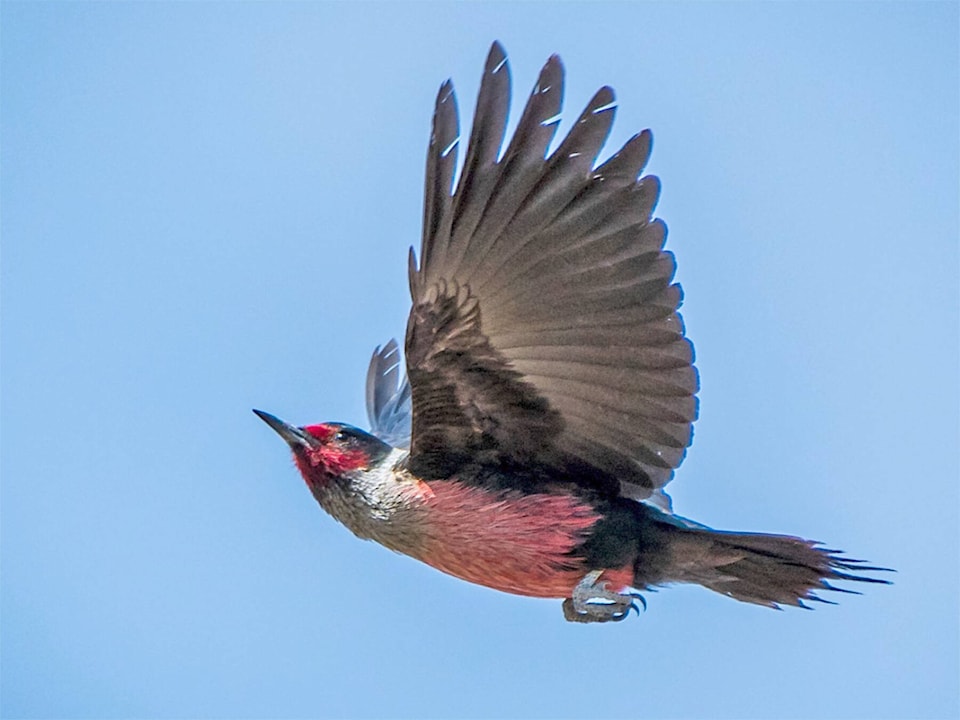With riparian areas being replanted in North Ruckle, Jenny Coleshill asked City Council if it’s going to have a stewardship agreement to replace trees critical to the habitat of a threatened bird species in the rest of the Grand Forks area.
Speaking on behalf of the Granby Wilderness Society, she was before council April 15 to ask about plans to replace damaged and destroyed cottonwood trees, which are vital nesting sites for the Lewis’s Woodpecker and vital to several other bird species.
Citing a research paper, she said the trees are a known preferred nesting site for the woodpecker, which is currently listed as threatened and teetering towards endangered.
Grand Forks has the distinction of being a major nesting area for the species during breeding season, she said, but nest sites have dwindled since a survey taken in 2012 as trees have been removed for various reasons from flood damage, to disease and other hazards.
Most of these haven’t been replaced, she said.
“In 2012, there were 52 known nests in the area, and Grand Forks had the highest density of these nests in the country,” she said. Last summer we found 36 nests, a 30 per cent decrease.”
As well, they are important for several other bird species for their overall survival.
“These big, beautiful trees are important for many reasons,” she said. Bald eagles use tips for perching on. They can’t land or take off from some of these smaller trees. This is really important, especially in the winter when they are cleaning up the dead deer off the river.”
There has been some planting in the city, but with limited success, she said. She and a few others wanted to plant cottonwood trees themselves and asked the city last year for assistance, but received no response, she added.
Cottonwoods are among the 18,000 trees being planted as part of the riparian and habitat restoration work for the Disaster Mitigation and Flooding (DMAF) plans, explained CAO Duncan Redfearn. He added part of the plan is to identify species of concern and special habitats for threatened or endangered species.
One question Coleshill had was on the protection status of these trees, which she said she was sure they were federally protected. Graham Watt, Manager of Strategic Initiatives, Flood Recovery for the city, explained there are tiers of actions needed to be taken with identified species, adding he had spoken to the biologist in charge about applying for riparian zones for these species on the city’s behalf.
”Because of the status of the Lewis’s Woodpecker, they need to be protected while they are here for the season,” said Watt. “But in the wintertime, as long as the nests aren’t identified as being active, there isn’t a need for permits.”
He added the city can apply for permits in the offset plan to go above and beyond. A few thousand cottonwoods have been planted in the east side of North Ruckle. More will be planted in the west side of North Ruckle in the riparian area.
While a good start, Coleshill said a few cottonwoods in one area wasn’t enough, considering the habitat of the woodpecker covered the entire city and into rural areas.
During the regular council meeting, Mayor Everett Baker said the city does everything it can to replace trees that have been removed, but safety issues and other factors come into play.
“Through our various permits we are required to have, I’d be very surprised if there was a permit we negated,” he said “Our staff are very diligent to make sure that all those T’s are crossed and I can assure you, if those T’s aren’t crossed, government wouldn’t be giving us any money.”
In the delegation form, the city was asked to enter into a stewardship agreement with Jenny, meaning city would provide in-kind service, said Redfearn.
Councillor Rod Zielinski asked before going forward with stewardship, he wanted wanted more information, asking to see the 2019 paper Graham wrote to see where the city is at right now with habitat protection, with Councillors Deborah Lafleur and David Mark asking if Coleshill is looking for a stewardship, both would like to know some details.
